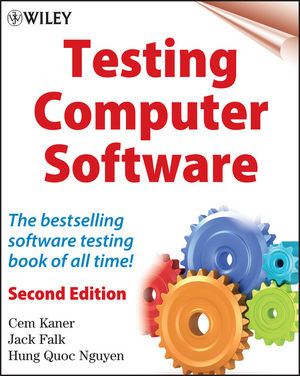Testing Computer Software, 2nd EditionISBN: 978-0-471-35846-6
Paperback
496 pages
April 1999
 This is a Print-on-Demand title. It will be printed specifically to fill your order. Please allow an additional 10-15 days delivery time. The book is not returnable.
|
||||||
Preface xiii
Notes on the book’s structure and layout xvii
Acknowledgments xxi
SECTION 1—FUNDAMENTALS
1. An example test series 1
The first cycle of testing 1
The second cycle of testing 11
What will happen in later cycles of testing 16
2. The objectives and limits of testing 17
You can’t test a program completely 17
The tester’s objective: Program verification? 23
So, why test? 25
3. Test types and their place in the software development process 27
Overview of the software development stages 30
Planning stages 32
Testing during the planning stages 33
Design stages 35
Testing during the design stages 39
Glass box code testing is part of the coding stage 41
Regression testing 49
Black box testing 50
Maintenance 57
4. Software errors 59
Quality 59
What is a software error? 60
Categories of software errors 60
5. Reporting and analyzing bugs 65
Write Problem Reports immediately 66
Content of the Problem Report 66
Characteristics of the Problem Report 74
Analysis of a reproducible bug 76
Tactics for analyzing a reproducible bug 79
Making a bug reproducible 82
SECTION 2—SPECIFIC TESTING SKILLS
6. The problem tracking system 87
The prime objective of a problem tracking system 90
The tasks of the system 90
Problem tracking overview 90
The users of the tracking system 97
Mechanics of the database 106
Further thoughts on problem reporting 115
Glossary 121
7. Test case design 123
Characteristics of a good test 124
Equivalence classes and boundary values 125
Visible state transitions 132
Race conditions and other time dependencies 133
Load testing 134
Error guessing 135
Function equivalence testing: automation, sensitivity analysis & random input 135
Regression testing: checking whether a bug fix worked 139
Regression testing: the standard battery of tests 140
Executing the tests 141
8. Testing printers (and other devices) 143
Some general issues in configuration testing 144
Printer testing 146
9. Localization testing 169
Was the base code changed? 170
Work with someone fluent in the language 170
Is the text independent from the code? 171
Translated text expands 171
Character sets 171
Keyboards 172
Text filters 172
Loading, saving, importing, and exporting high and low ASCII 173
Operating system language 173
Hot keys 173
Garbled in translation 173
Error message identifiers 174
Hyphenation rules 174
Spelling rules 174
Sorting rules 174
Uppercase and lowercase conversion 174
Underscoring rules 174
Printers 175
Sizes of paper 175
CPU’s and video 175
Rodents 175
Data formats and setup options 175
Rulers and measurements 176
Culture-bound graphics 176
Culture-bound output 176
European product compatibility 176
Memory availability 176
Do GUIs solve the problem? 177
Automated testing 177
10. Testing user manuals 179
Effective documentation 179
The documentation tester’s objectives 180
How testing documentation contributes to software reliability 181
Become the technical editor 182
Working with the manual through its development stages 183
Online help 188
11. Testing tools 189
Fundamental tools 189
Automated acceptance and regression tests 191
Standards 197
Translucent-box testing 200
12. Test planning and test documentation 203
The overall objective of the test plan: product or tool? 204
Detailed objectives of test planning and documentation 205
What types of tests to cover in test planning documents 210
A strategy for developing components of test planning documents 213
Components of test planning documents 217
Documenting test materials 242
A closing thought 253
SECTION 3—MANAGING TESTING PROJECTS AND GROUPS
13. Tying it together 255
Software development tradeoffs 257
Software development models 258
Quality-related costs 264
The development time line 266
Product design 267
Fragments coded: first functionality 274
Almost alpha 275
Alpha 277
Pre-beta 286
Beta 286
User interface (UI) freeze 293
Pre-final 295
Final integrity testing 299
Release 301
Project post-mortems 301
14. Legal consequences of defective software 303
Breach of contract 305
Torts: lawsuits involving fault 317
Whistle blowing 340
15. Managing a testing group 343
Managing a testing group 344
The role of the testing group 345
A test group is not an unmixed blessing 349
An alternative? Independent test agencies 350
Scheduling tips 352
Your staff 359
Appendix: common software errors 363
User interface errors 375
Error handling 396
Boundary-related errors 399
Calculation errors 401
Initial and later states 403
Control flow' errors 406
Errors in handling or interpreting data 416
Race conditions 421
Load conditions 423
Hardware 427
Source, version, and ID control 430
Testing errors 432
References 437
Index 451
About the Authors 480



